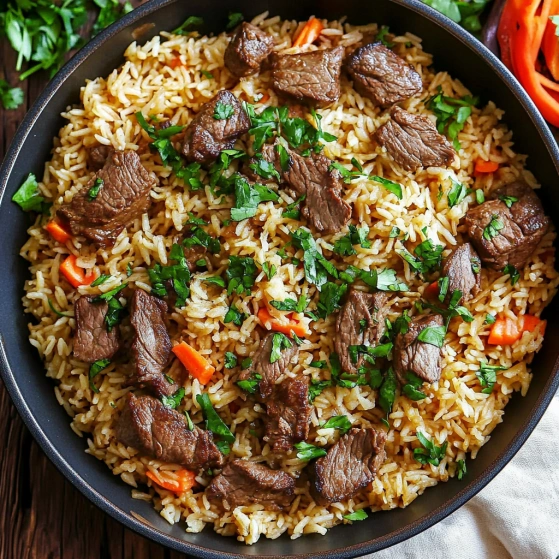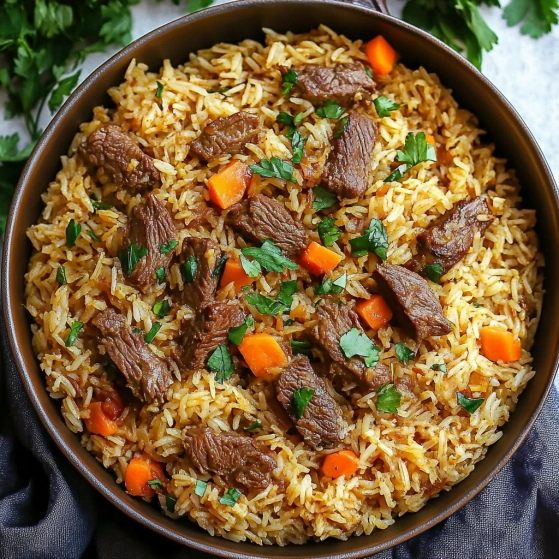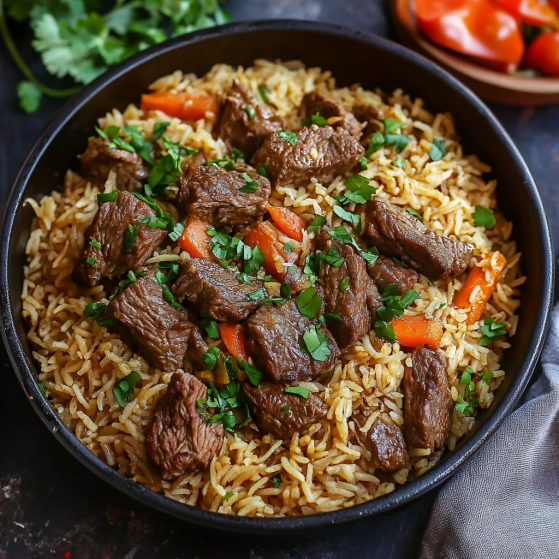 Pin it
Pin it
This fragrant and hearty beef rice plov brings together tender chunks of beef, aromatic spices, and perfectly cooked rice for a complete one-pot meal. The combination creates a symphony of flavors that makes this dish a true comfort food masterpiece.
I first made this plov for my husband after he mentioned missing the Central Asian food from his childhood. The look on his face when he took that first bite was priceless. Now it has become our go-to dish when hosting family gatherings.
Ingredients
- Chuck beef: Creates the richest flavor base but any roasting cut works beautifully
- Olive oil: Helps develop deep flavor through proper searing
- Yellow onions: Provide essential sweetness that balances the savory elements
- Carrots: Add natural sweetness and beautiful color contrast
- Jasmine rice: Absorbs flavors wonderfully while maintaining distinct grains
- Whole garlic head: Infuses the entire dish with subtle aromatic notes
- Cumin: Brings earthy warmth that defines authentic plov
- Turmeric: Contributes gorgeous golden color and subtle flavor
- Curry powder: Adds complexity without overwhelming other ingredients
- Smoked paprika: Introduces a gentle smokiness that enhances the beef
Step-by-Step Instructions
- Sear the Beef:
- Heat olive oil in a large Dutch oven until shimmering hot. Work in batches to properly brown beef pieces on all sides until they develop a rich crust. This step is crucial for developing deep flavor in the final dish. Patience here pays off tremendously.
- Build the Flavor Base:
- Return all seared beef to the pot and add chopped onions. Cook together until onions become translucent and start turning golden. This stage begins to create the aromatic foundation that will infuse throughout the entire dish.
- Add the Vegetables:
- Incorporate thickly sliced carrots into the beef and onion mixture. Cook for several minutes until carrots slightly soften but still maintain some firmness. The vegetables should begin releasing their natural sweetness into the dish.
- Bloom the Spices:
- Add all measured spices to the pot and stir thoroughly to coat meat and vegetables. Cooking the spices directly with the hot ingredients helps release their essential oils and intensifies their flavors throughout the dish.
- Simmer to Tenderness:
- Pour in 6 cups of water covering the meat mixture. Bring to a boil before reducing to a medium simmer. Cook partially covered for about an hour until beef becomes fork tender. This slow cooking process allows the meat fibers to break down properly.
- Prepare the Rice:
- Thoroughly rinse rice until water runs clear to remove excess starch. This critical step ensures properly separated grains in the finished dish rather than a gummy texture.
- Layer and Steam:
- Spread rinsed rice evenly over the meat mixture without stirring. Add boiling water to cover the rice and nestle the trimmed garlic head in the center. Cover completely and cook undisturbed until rice absorbs all liquid and becomes tender.
- Finish the Dish:
- Remove the garlic head and gently fluff the rice with a fork. Carefully mix the components to distribute the meat throughout without mashing the rice grains. The finished dish should have distinct grains and perfectly tender meat.
 Pin it
Pin it
This dish reminds me of my grandmother who taught me that good cooking requires patience. She would always say the key to perfect plov is allowing the meat to develop its flavor slowly before adding the rice. I still hear her voice every time I make this recipe.
The History Behind Plov
Plov traces its origins to Central Asia particularly Uzbekistan where it remains a national dish. Traditionally prepared by men for special occasions like weddings and celebrations it represents hospitality and generosity. The technique of layering ingredients rather than mixing them together is what distinguishes authentic plov from simple rice dishes. Each region has its own variation but the core elements of meat rice and carrots remain consistent throughout.
Storage and Reheating
Plov actually improves in flavor after sitting overnight in the refrigerator. Store leftovers in airtight containers for up to 3 days. When reheating add a small splash of water to prevent drying and warm over medium heat covered until steaming hot. For best results use a heavy bottomed pan rather than a microwave to maintain the texture of both rice and meat. Plov also freezes beautifully for up to 3 months when stored in freezer safe containers.
Ingredient Substitutions
This versatile recipe welcomes adaptations based on what you have available. Lamb makes an excellent alternative to beef offering a more traditional flavor profile. Brown rice can replace white rice though cooking time will need to increase by about 15 minutes. For a vegetarian version replace meat with 2 pounds of mushrooms and use vegetable broth instead of water. The spice blend can be simplified to just cumin salt and pepper if you prefer a more subtle flavor profile.
 Pin it
Pin it
Serving Suggestions
In Central Asian tradition plov is often served on a large communal platter with fresh herbs like cilantro or dill scattered on top. Accompany with a simple salad of sliced tomatoes cucumbers and red onions dressed with lemon juice and salt. Tangy yogurt makes an excellent side offering cooling contrast to the rich flavors. For authentic presentation include the whole roasted garlic head on top of the rice and let guests squeeze out the soft cloves to enjoy with their portion.
Frequently Asked Questions
- → What cut of beef works best for plov?
Chuck beef is ideal for plov because it has good marbling that becomes tender when slowly cooked. However, any roasting beef like brisket, round, or shoulder cuts will work well. The key is using meat that benefits from slow cooking to become tender while flavoring the rice.
- → Can I use a different type of rice for plov?
Yes, while jasmine rice is specified, any long-grain rice works well. Basmati is an excellent alternative that holds its shape nicely. Avoid short-grain or sticky rice varieties as they will create a texture that's too glutinous for authentic plov.
- → Why is the garlic head kept whole in plov?
The whole garlic head is a traditional technique that infuses the dish with gentle garlic flavor without overwhelming it. As it cooks, the garlic softens and sweetens. The roasted cloves can be squeezed out and eaten alongside the plov or mixed in for extra flavor.
- → Is it necessary to rinse the rice before cooking?
Yes, rinsing the rice is crucial for plov. It removes excess starch from the grains, which prevents the rice from becoming sticky or mushy. Rinse until the water runs clear to ensure each grain will remain separate and fluffy in the finished dish.
- → Can plov be made in advance?
Plov actually improves with time as the flavors meld together. You can make it a day ahead and reheat gently with a splash of water. For best results when reheating, use low heat and cover the pot to allow the dish to steam through without drying out.
- → What are traditional accompaniments for plov?
Plov is often served with fresh herbs like cilantro or dill, a simple salad of tomatoes and onions dressed with lemon juice, or pickled vegetables. Yogurt or a yogurt-based sauce with garlic and herbs makes a cooling side that balances the rich, spiced dish.
